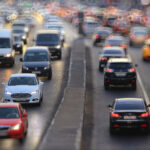During the week of June 5, the Northeast United States found itself coated in orange smoke and smog stemming from the ongoing wildfires in eastern Canada. It was an unusual experience for those unfamiliar with wildfires and the smoke-related air pollution they cause, and the latest reports indicate that the wildfires may only continue to intensify. In fact, according to the EPA, climate change has slowly increased the length, frequency and burn areas of wildfire seasons. For the insurance industry, these wildfires represent a unique and often complex issue, as the adjusting process for smoke damage can be nuanced and involve testing.
To address air pollutants and related damage, many leading adjusting firms have a specialized group that is focused on evaluating both the health risks and potential damages of wildfire smoke. One of the things these expert groups have revealed is solid soot, char and ash that fill the air are the biggest concern for human inhalation. Solid particles of smoke that are smaller than 2.5 microns can penetrate deep into the lungs and cannot be seen with the human eye. Smoke particles also can have a varying impact on those who inhale them, and those with existing pulmonary conditions are at a heightened risk.
Some states, like California, have instituted laws to protect outdoor workers from wildfire smoke, but this isn’t the case everywhere. Therefore, it is crucial for claimants to understand how different state laws can impact outcomes. For claims related to people and their health, environmental professionals often sample the indoor air with specialized meters to determine if a workplace has levels of smoke particles and various other toxic contaminants deemed safe by authorities. The EPA also produced its own app, called AirNow, which shows known airborne pollution levels throughout the U.S. and is a fantastic mobile-based tool for people to leverage when making travel or outdoor activity decisions or for businesses conducting outdoor projects in an area potentially impacted by smoke pollution.
The potential damage caused by wildfire smoke extends beyond just people. The very same solid soot, char, ash and various chemicals in the air also can impact properties and their contents. This includes everything from causing unpleasant odors and some minor, cleanable dust deposition to extreme and more rare cases, where the fire is adjacent and potentially causes selective physical damage to an interior or exterior, where the smoke is also particularly thick or corrosive. In this most recent smoke surge in the Northeast from far distant fires, the EPA does not foresee long-lasting health impacts for most healthy people. People more vulnerable to smoke must take additional steps to limit exposure.
Claims professionals for the most part recommend cleaning and deodorization, if necessary, for impacted structures and contents since wildfire smoke typically does not permanently damage most materials. Claims professionals can provide helpful and value-added advice to the insured, but the level of any assessment, testing or supplemental cleaning would be based on policy coverage.
Smoke damage claim evaluations are for the most part commonsense visual assessment and odor detection. Soot sponges can provide a direct qualitative indicator of potential fire deposition. For questionable or contested damage claims, surface sampling may be required. Claims professionals can additionally evaluate the exterior, interior, HVAC system and contents of a building to determine whether the smoke has created an impact greater than non-impacted “background.” Here’s what that means: Determining the impact of wildfire smoke is complex because of environmental factors, such as long-term air pollution impacts or site fireplace depositions. These can muddy the analysis, and investigators strive to find surfaces with both pre- and post-wildfire loss deposition to sample, generally with a tape-lift for subsequent laboratory microscopy analysis. The presence of wildfire indicator particles, such as burnt plants, minerals and pollens, may demonstrate an assemblage of particles which likely came from an outdoor fire. It can be a laborious process, since, for example, many older buildings can have existing cross-contamination from years of indoor/outdoor dust not being cleaned, such as in an old attic.
Ultimately, wildfire prevention is an increasingly shared responsibility, and while awareness is rising, climate change continues to exacerbate the issue. It’s important for both people and businesses to take steps to protect themselves. For example, utilities have been hardening their infrastructure against electrical fires, and many homeowners and builders may be facing regulatory requirements to protect buildings in wilderness areas, such as creating buffers or defensible spaces. Similarly, many companies now market small plug-in air particle meters that are affordable for homeowners. Whatever the case, these small changes can go a long way to prevent wildfire damage before it even happens and ultimately help individuals and businesses alike avoid having to make a wildfire damage claim in the first place.
Featured photo: An aerial view shows New York City in a haze-filled sky from the Empire State Building observatory, Wednesday, June. 7, 2023, in New York. Smoke from Canadian wildfires poured into the U.S. East Coast and Midwest on Wednesday, covering cities of both nations in an unhealthy haze, holding up flights at major airports and prompting people to fish out pandemic-era face masks. (AP Photo/Yuki Iwamura)





















 IRC Finds 1 in 3 U.S. Drivers Are Either Uninsured or Underinsured
IRC Finds 1 in 3 U.S. Drivers Are Either Uninsured or Underinsured  Performance Review: Why Insurers Struggle to Underwrite, Price and Reserve for Commercial Auto Risks
Performance Review: Why Insurers Struggle to Underwrite, Price and Reserve for Commercial Auto Risks  Berkshire, Progressive Are 2024 Underwriting Profit Leaders; Industry Income Record
Berkshire, Progressive Are 2024 Underwriting Profit Leaders; Industry Income Record  The Growth of a New Wave of Distribution Startups in Commercial Auto Insurance
The Growth of a New Wave of Distribution Startups in Commercial Auto Insurance 

